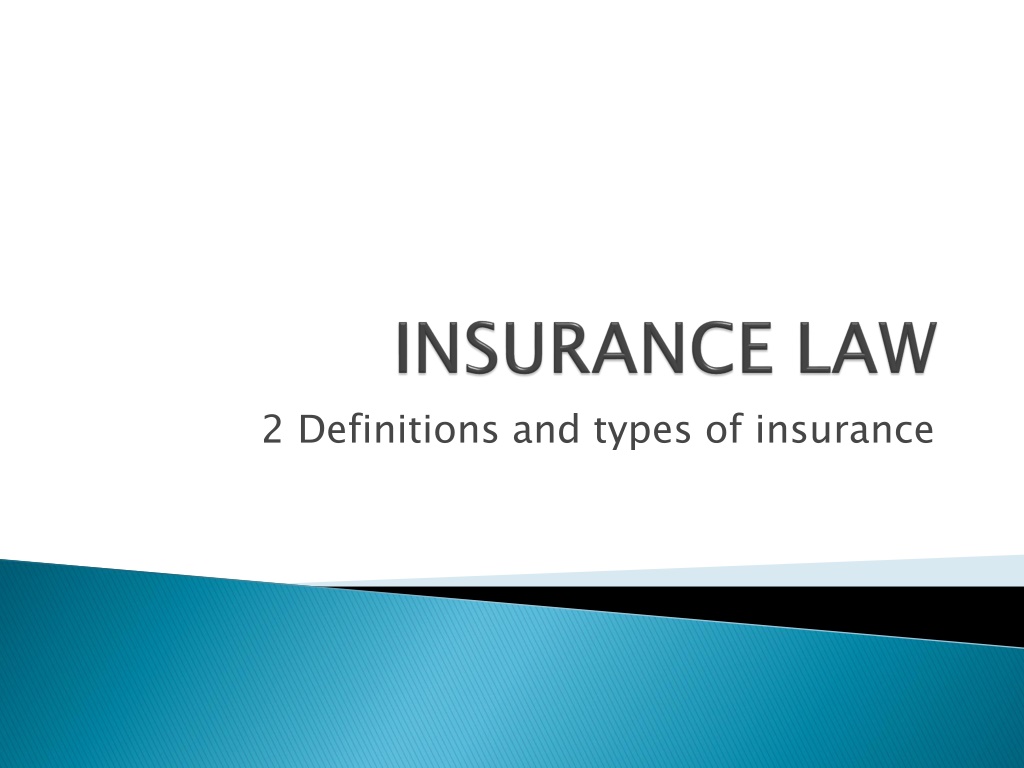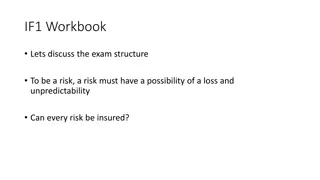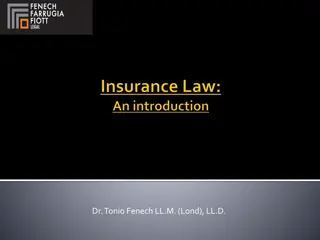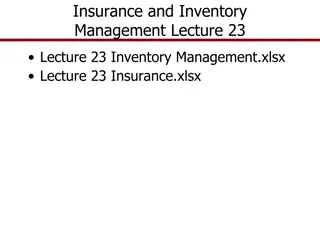Definitions and Types of Insurance
Insurance can be viewed through various disciplines such as law, economics, and sociology. It involves a company or state guaranteeing compensation for specified loss, damage, or death in exchange for a premium. Insurance provides financial protection for unforeseen events and transfers risk from the insured to the insurer. The concept revolves around uncertain events and contingencies, with insurers promising payouts upon the occurrence of specified events.
Uploaded on Sep 24, 2024 | 1 Views
Download Presentation

Please find below an Image/Link to download the presentation.
The content on the website is provided AS IS for your information and personal use only. It may not be sold, licensed, or shared on other websites without obtaining consent from the author.If you encounter any issues during the download, it is possible that the publisher has removed the file from their server.
You are allowed to download the files provided on this website for personal or commercial use, subject to the condition that they are used lawfully. All files are the property of their respective owners.
The content on the website is provided AS IS for your information and personal use only. It may not be sold, licensed, or shared on other websites without obtaining consent from the author.
E N D
Presentation Transcript
Can be defined from viewpoint of several disciplines such as law, economics, history actuarial science, risk theory, sociology.
Insurance company or the state undertakes to provide a guarantee of compensation for specified loss, damage, payment of a specified premium. Insurance an arrangement by which a illness, or death in return for /Oxford dictonary/
Insurance full or partial financial compensation for the loss or damage caused by events beyond the control of contract, a party (the insurer) indemnifies the other party (the insured) against a specified amount eventualities within a specified period, provided a fee called premium is paid. In general insurance, compensation is normally proportionate to the loss incurred, whereas in life insurance usually a fixed sum is paid. Insurance risk-transfer mechanism that ensures the insured party. Under an insurance of loss, occuring from specified /businessdictionary.com/
Insurance promises to pay the insured a sum of money or some other benefit upon the happening of one or more uncertain events in exchange for the payment of a premium. There must be uncertainty as to whether the relevant events may happen at all or, if they will occur (e.g. death) as to their timing. Insurance a contract whereby an insurer /Lloyd s Glossary/
Insurance loss of unknown magnitude for a small and known loss. Insurance is the exchange of an uncertain /P. Zweifel and R.Eisen, Insurance Economisc/ Insurance money payable contingent on the occurence of certain loss. Insurance is the exchange of money now for /K. Arrow, Aspects of the Theory of Risk-Bearing/
Insurance by agree to occurence with Insurance is is the by transferer agree to to provide occurence, , or with the the pooling of such indemnify insureds provide other or to the risk pooling of such risk insureds for other pecuniary to render risk. . of fortuitous risk to for such pecuniary benefits render services fortuitous losses to insurers such losses benefits on services connected losses who losses, , on their connected transferer of to indemnify insurers, , who their /A definition of insurance by the Commission on Insurance Terminology of the American Risk and Insurance Assocation/
Pooling of losses Payment of fortuitous losses Risk transfer Indemnification
Pooling (sharing) means spreading of losses incurred by the few over the entire group, so that in the process average loss is substituted for actual loss. Pooling involves the grouping of a large number of exposure units to provide a substantially accurate prediction of future losses. Ideally, there should be a large number of similar, but not necessarily identical, exposure units that are subject to the same perils.
Risk transfer means that a pure risk is transferred form the insured to the insurer, who typically is in a stronger financial position to pay the loss than the insured.
Indemnification means that the insured is restored to his or her approximate financial position prior to the occurence of the loss.
A contract for transfer of risk entity pays a relatively small amount for a certain loss (premium) to transfer the risk of a much larger loss to another entity. where one It is usually charecterized by 3 elements: 1. risk-distribution, 2. among substuncial number of members, 3. through an insurer engaged primarily in the business of insurance.
A A contract one party assuemes the risk of an uncertain event, which is not within his control, happening at a future time in which the insured party has an interest and under which contract the first party is bound to pay money or provide its equivalent if the uncertain event occurs. It is also generally assumed that the event must be one not within the control of the assured either. It would follow that anyone who enters such contracts as the party bearing the risks, all else being equal, is carrying on insurance business for the purposes of the statute regulating insurance business. contract of of insurance insurance is any contract whereby
art 1 1 within the scope of his enterprise's activity to render specified performance when an accident envisaged in the contract occurs and the insuring party undertakes to pay a premium. 2 a payment: in the case of property insurance - of specified damages for the damage arising due to an accident envisaged in the contract; in the case of personal insurance - of a sum of money agreed on, a pension or other performance when an accident envisaged in the contract occurs in the life of the insured party. art. . 805 805 of By the contract of insurance of Polish Polish Civil Civil Code Code insurance the insurer undertakes 2 The insurer's performance shall involve in particular
Public insurance governmental insurance Social insurance programs Private insurance Private insurers generally insure only pure risks. However, some pure risk are not privately insurable.
Casualty Property Marine Energy Motor Aviation Reinsurance
Life insurance Life insurance Health insurance Health insurance Property insurance Property insurance Liability Liability insurance insurance
Life designated beneficiaries when the insured dies. insurance pays death benefits to
Life insurance is characterized as a form of investment, whereby the policyholder makes periodic ultimately to be paid for the support of a beneficiary other than the insured after his or her death. contributions to a fund that is The loss to the beneficiary caused by the death of the insured can seldom be measured accurately in terms of cash value.
Individual or group health insurance plans. Covers physician fees, prescription drugs, and other medical costs. hospital and surgical expenses,
Property insurance indemnifies property owners against the loss or damage of real or personal property caused by various perils.
Property indemnity restoration, dollar for dollar, as nearly as possible within policy limits, usually to the policyholder, of the value of the thing lost. insurance is purely a form of
Liability insurance covers the insureds legal liability arising out of property damage or bodily defense costs are also covered. harm to others. Sometimes legal Also called third party insurance, because it covers the policyholder against third party losses, i.e. losses incurred by third parties for which the policyholder is liable.
Package policies combine various types of specified-risk coverage ordinarily covered by separate policies, into one comprehensive policy. From the policyholder s perspective, all-risk attractive coverage and reduce the burden of proof the policyholder is typically required to prove in order to obtain coverage because the insurer has excluded. insurance because policies they are the most provide broader teh burden of proving the loss is
Who Who or or what what may may be be insured insured and and by by whom whom. . Insurable derives a financial or other kind of benefit from the continuous existence, without impairment or damage, of the insured object (or in the case of a person, their continued survival). A A person an or to Insurable interest interest exists when an insured person person has when loss cause the kind of has of an insurable or damage to suffer insurable interest damage to suffer a a financial interest in to that financial or in something thing would or other something when would cause other kind loss of person that thing the person of loss loss. . Typically, insurable interest is established by ownership, possession, or direct relationship.
Poor risk Unacceptable risk Ideally insurable risk
There must be a large number of exposure units. The loss must be accidental and unintentional. The loss must be determinabe and measurable. The loss should not be catastrophic. The chance of loss must be calculable (both the average frequency and the average severity of future losses). The premium must be economically feasible. 1. 2. 3. 4. 5. 6.
A large group of similar exposure units that are subject to the same peril or group of perils. It is to enable the insurer to predict loss based on the law of large numbers.
The unexpected the insured s control. loss should be unforseen unforseen and unexpected by the insured and be outside of If If an should an individual should not be individual deliberately not be indemnificated deliberately causes indemnificated for causes a a loss for the loss, , he the loss he or or she she loss. .
The loss should be detrminate as to cause, time, place, and amount. The basic purpose of this requirement is to determine if the loss is covered under the policy, and if it is covered, hom much should be paid.
Ideally the loss should not be catastrophic. This exposure units should not incur losses at the same time. means that a large proportion of In catastrophic losses periodically result from floods, forest Catastrophic losses can also result from acts of terrorism. reality it is impossible, because hurricanes, fires tornados, other earthquakes, natural and disasters.
Chance of loss should be calculable insurer must be able to calculate both the average frequency and the average severity of future losses with some accuracy in order to calculate proper premium that is sufficient to pay all claims and expenses and yields a profit during the policy period. calculable. . The
Premium to be paid by the insured should be economically feasible. The insured must be able to afford the premium. For insurance to be an attractive purchase the premiums paid must be substancially less than the face value (nominal value) or amount of the policy. Total amount of insurance. premium cannot exceed the face

 undefined
undefined























